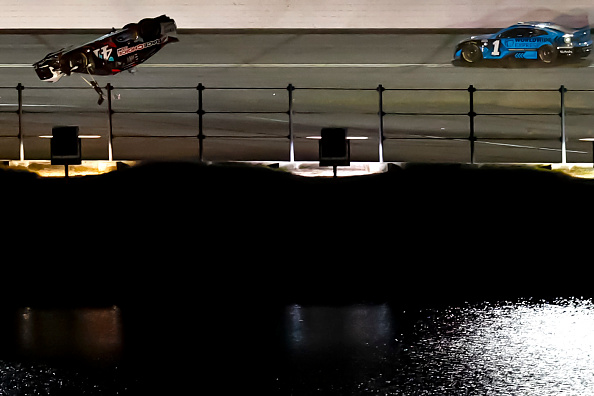NASCAR’s Ryan Preece Takes Wild Ride At Daytona
So glad that Ryan Preece is okay after this scary accident at Daytona over the weekend. Everyone talks about the “Big One” in NASCAR on the superspeedways, but this was startling in how quickly his car went end over end (at least 10 barrel rolls).
Fortunately Ryan was released from the local hospital and is resting comfortably in North Carolina.

DAYTONA BEACH, FLORIDA – AUGUST 26: Ryan Preece, driver of the #41 RaceChoice.com Ford, flips after an on-track incident during the NASCAR Cup Series Coke Zero Sugar 400 at Daytona International Speedway on August 26, 2023 in Daytona Beach, Florida. (Photo by Sean Gardner/Getty Images)

DAYTONA BEACH, FLORIDA – AUGUST 26: Ryan Preece, driver of the #41 RaceChoice.com Ford, and Chase Briscoe, driver of the #14 Magical Vacation Planner Ford, spin after an on-track incident during the NASCAR Cup Series Coke Zero Sugar 400 at Daytona International Speedway on August 26, 2023 in Daytona Beach, Florida. (Photo by Sean Gardner/Getty Images)

DAYTONA BEACH, FLORIDA – AUGUST 26: Ryan Preece, driver of the #41 RaceChoice.com Ford, and Chase Briscoe, driver of the #14 Magical Vacation Planner Ford, spin after an on-track incident during the NASCAR Cup Series Coke Zero Sugar 400 at Daytona International Speedway on August 26, 2023 in Daytona Beach, Florida. (Photo by Sean Gardner/Getty Images)

DAYTONA BEACH, FLORIDA – AUGUST 26: Ryan Preece, driver of the #41 RaceChoice.com Ford, flips after an on-track incident during the NASCAR Cup Series Coke Zero Sugar 400 at Daytona International Speedway on August 26, 2023 in Daytona Beach, Florida. (Photo by Sean Gardner/Getty Images)

DAYTONA BEACH, FLORIDA – AUGUST 26: Ryan Preece, driver of the #41 RaceChoice.com Ford, flips after an on-track incident during the NASCAR Cup Series Coke Zero Sugar 400 at Daytona International Speedway on August 26, 2023 in Daytona Beach, Florida. (Photo by Sean Gardner/Getty Images)
This reminded me of a crash at Talladega years ago involving Rusty Wallace going airborne at the end of a race.
Now here in Detroit we have a long history with NASCAR – going back to 1951 and the Michigan State Fairgrounds. Did you know that?
Back in 1951 Bill France, the President of NASCAR, decided to bring racing to Detroit for the cities 250th birthday. Thus the Motor City 250 was born at the Michigan Fairgrounds – stock car racing on a one mile dirt oval.
France knew he needed to put on a show for the auto manufacturers, so pre-race entertainment had everything from fireworks, balloons and even a “feigned” dogfight between mini model airplanes. Over 16,000 people turned out to see the spectacle.
What kind of race was it? This piece in the Detroit News described it best:
Trouble on the trackBefore the race, the southeast corner of the race track was smooth.
That evening, after four hours, 21 minutes and 28 seconds of raucous, repeatedly violent racing, the ruts and holes dug into the perilous turn by careening, braking, accelerating, crashing, flipping, catapulting race cars made it serrated.
A reporter for The Detroit News described the deteriorating, increasingly risky conditions during the race.
“The turn was rougher than the Detroit River with the wind blowing hard upstream,” Harry Leduc wrote. “It looked from the press box as if the cars were driving on seas, instead of soil.”
The ensuing mayhem was, at times, extreme, almost like the old newsreels of humans’ first attempts at flight.
“There were five leaders,” Leduc wrote. “The lead changed 12 times. There was one seven-car smash up and one five-car crash. There were numerous solo events with machines rolling over, plunging into fences, throwing wheels, blowing tires, boiling over.
“Spectators were alternately aghast and cheering, infield fans racing hither and dither to scenes of destruction with police on horses and on motorcycles checking the concentrations.”When drivers wrecked, fans would leave their seats or positions in the infield to sprint to the scenes, often arriving before ambulances and wreckers, driven by a mixture of curiosity and compassion.
Among those rolling his car that day was Lee Petty, NASCAR great Richard Petty’s father. He did it on lap 90, losing his windshield.
But Petty drove his Plymouth 160 miles through the dirt and dust, wiping his goggles with his handkerchief, to finish 13th, 17 laps behind.

